brakes VOLVO V90 2017 Owners Manual
[x] Cancel search | Manufacturer: VOLVO, Model Year: 2017, Model line: V90, Model: VOLVO V90 2017Pages: 594, PDF Size: 15.07 MB
Page 92 of 594
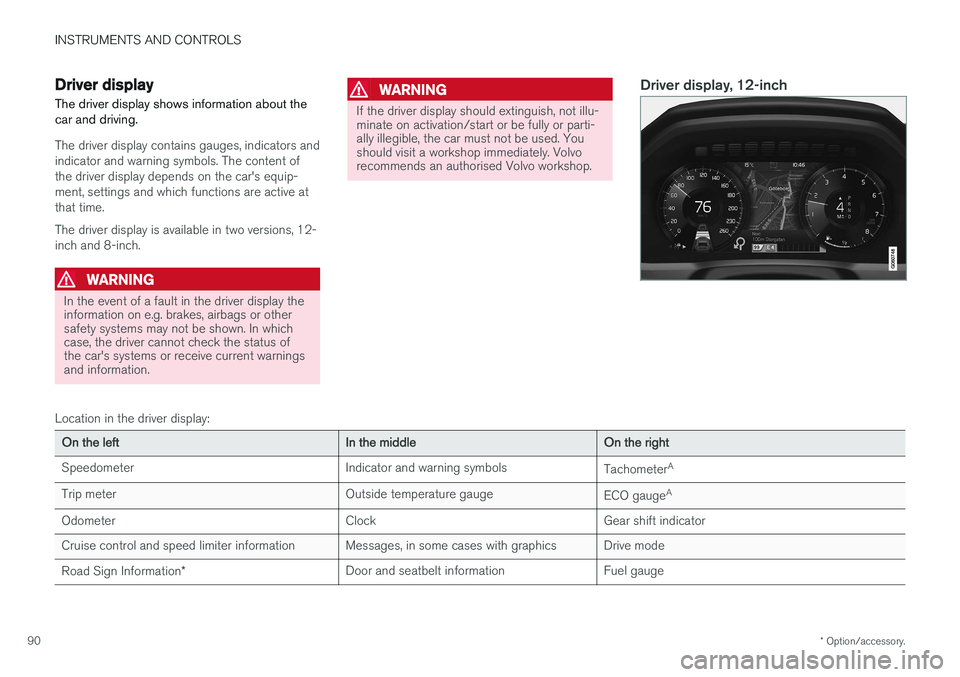
INSTRUMENTS AND CONTROLS
* Option/accessory.
90
Driver display
The driver display shows information about the car and driving.
The driver display contains gauges, indicators and indicator and warning symbols. The content ofthe driver display depends on the car's equip-ment, settings and which functions are active atthat time. The driver display is available in two versions, 12- inch and 8-inch.
WARNING
In the event of a fault in the driver display the information on e.g. brakes, airbags or othersafety systems may not be shown. In whichcase, the driver cannot check the status ofthe car's systems or receive current warningsand information.
WARNING
If the driver display should extinguish, not illu- minate on activation/start or be fully or parti-ally illegible, the car must not be used. Youshould visit a workshop immediately. Volvorecommends an authorised Volvo workshop.
Driver display, 12-inch
Location in the driver display:
On the left In the middleOn the right
Speedometer Indicator and warning symbols
TachometerA
Trip meter Outside temperature gauge
ECO gaugeA
Odometer ClockGear shift indicator
Cruise control and speed limiter information Messages, in some cases with graphics Drive mode Road Sign Information * Door and seatbelt information Fuel gauge
Page 145 of 594
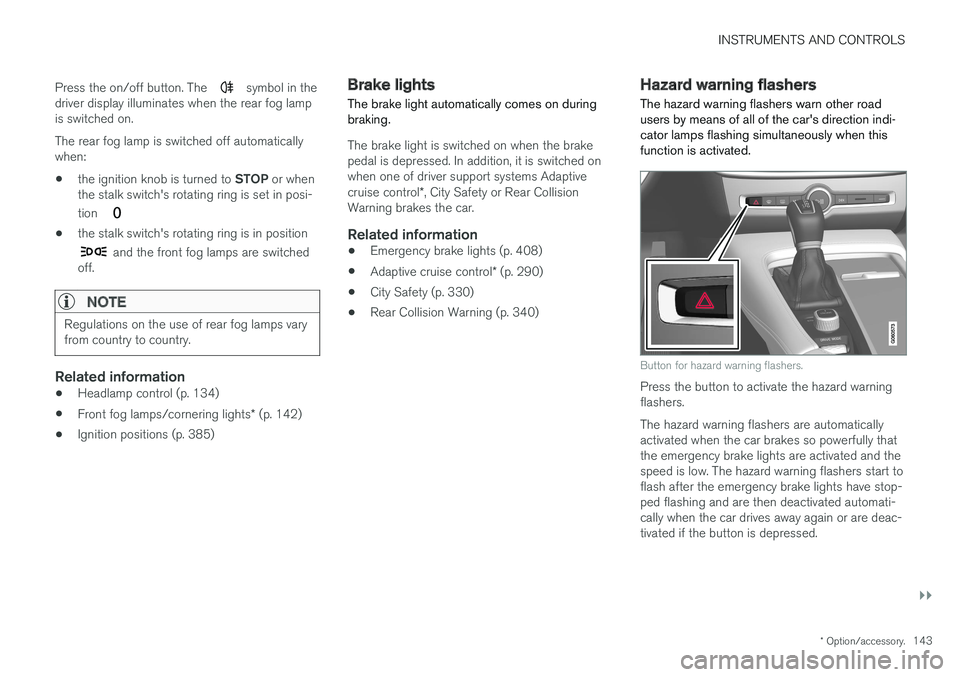
INSTRUMENTS AND CONTROLS
}}
* Option/accessory.143
Press the on/off button. The
symbol in the
driver display illuminates when the rear fog lamp is switched on. The rear fog lamp is switched off automatically when:
• the ignition knob is turned to
STOP or when
the stalk switch's rotating ring is set in posi- tion
• the stalk switch's rotating ring is in position
and the front fog lamps are switched
off.
NOTE
Regulations on the use of rear fog lamps vary from country to country.
Related information
• Headlamp control (p. 134)
• Front fog lamps/cornering lights
* (p. 142)
• Ignition positions (p. 385)
Brake lights The brake light automatically comes on during braking.
The brake light is switched on when the brake pedal is depressed. In addition, it is switched onwhen one of driver support systems Adaptive cruise control
*, City Safety or Rear Collision
Warning brakes the car.
Related information
• Emergency brake lights (p. 408)
• Adaptive cruise control
* (p. 290)
• City Safety (p. 330)
• Rear Collision Warning (p. 340)
Hazard warning flashers
The hazard warning flashers warn other road users by means of all of the car's direction indi-cator lamps flashing simultaneously when thisfunction is activated.
Button for hazard warning flashers.
Press the button to activate the hazard warning flashers. The hazard warning flashers are automatically activated when the car brakes so powerfully thatthe emergency brake lights are activated and thespeed is low. The hazard warning flashers start toflash after the emergency brake lights have stop-ped flashing and are then deactivated automati-cally when the car drives away again or are deac-tivated if the button is depressed.
Page 277 of 594
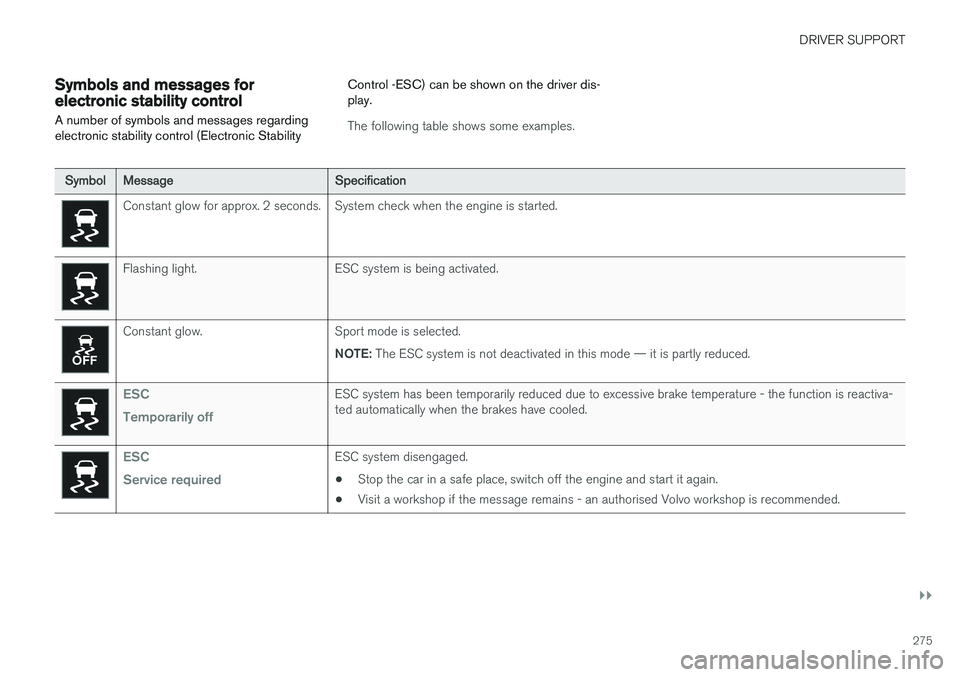
DRIVER SUPPORT
}}
275
Symbols and messages for electronic stability control
A number of symbols and messages regarding electronic stability control (Electronic Stability Control -ESC) can be shown on the driver dis-play.
The following table shows some examples.
Symbol
Message Specification
Constant glow for approx. 2 seconds. System check when the engine is started.
Flashing light. ESC system is being activated.
Constant glow. Sport mode is selected.
NOTE: The ESC system is not deactivated in this mode — it is partly reduced.
ESC Temporarily offESC system has been temporarily reduced due to excessive brake temperature - the function is reactiva- ted automatically when the brakes have cooled.
ESC Service requiredESC system disengaged.
• Stop the car in a safe place, switch off the engine and start it again.
• Visit a workshop if the message remains - an authorised Volvo workshop is recommended.
Page 293 of 594
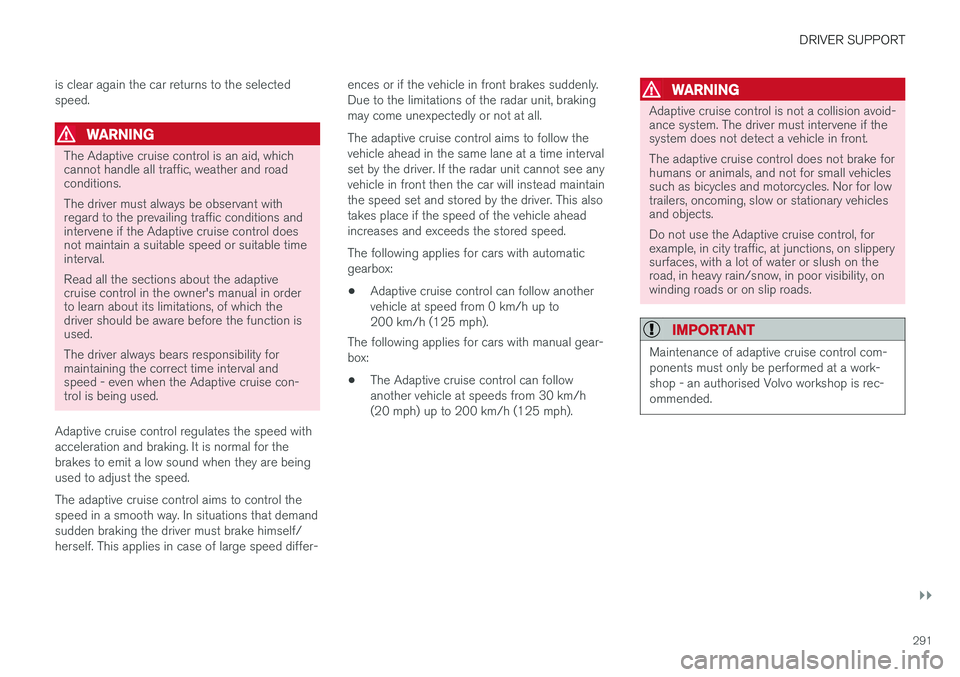
DRIVER SUPPORT
}}
291
is clear again the car returns to the selected speed.
WARNING
The Adaptive cruise control is an aid, which cannot handle all traffic, weather and roadconditions. The driver must always be observant with regard to the prevailing traffic conditions andintervene if the Adaptive cruise control doesnot maintain a suitable speed or suitable timeinterval. Read all the sections about the adaptive cruise control in the owner's manual in orderto learn about its limitations, of which thedriver should be aware before the function isused. The driver always bears responsibility for maintaining the correct time interval andspeed - even when the Adaptive cruise con-trol is being used.
Adaptive cruise control regulates the speed with acceleration and braking. It is normal for thebrakes to emit a low sound when they are beingused to adjust the speed. The adaptive cruise control aims to control the speed in a smooth way. In situations that demandsudden braking the driver must brake himself/herself. This applies in case of large speed differ- ences or if the vehicle in front brakes suddenly.Due to the limitations of the radar unit, brakingmay come unexpectedly or not at all. The adaptive cruise control aims to follow the vehicle ahead in the same lane at a time intervalset by the driver. If the radar unit cannot see anyvehicle in front then the car will instead maintainthe speed set and stored by the driver. This alsotakes place if the speed of the vehicle aheadincreases and exceeds the stored speed. The following applies for cars with automatic gearbox:
• Adaptive cruise control can follow anothervehicle at speed from 0 km/h up to200 km/h (125 mph).
The following applies for cars with manual gear-box: • The Adaptive cruise control can follow another vehicle at speeds from 30 km/h(20 mph) up to 200 km/h (125 mph).
WARNING
Adaptive cruise control is not a collision avoid- ance system. The driver must intervene if thesystem does not detect a vehicle in front. The adaptive cruise control does not brake for humans or animals, and not for small vehiclessuch as bicycles and motorcycles. Nor for lowtrailers, oncoming, slow or stationary vehiclesand objects. Do not use the Adaptive cruise control, for example, in city traffic, at junctions, on slipperysurfaces, with a lot of water or slush on theroad, in heavy rain/snow, in poor visibility, onwinding roads or on slip roads.
IMPORTANT
Maintenance of adaptive cruise control com- ponents must only be performed at a work-shop - an authorised Volvo workshop is rec-ommended.
Page 302 of 594
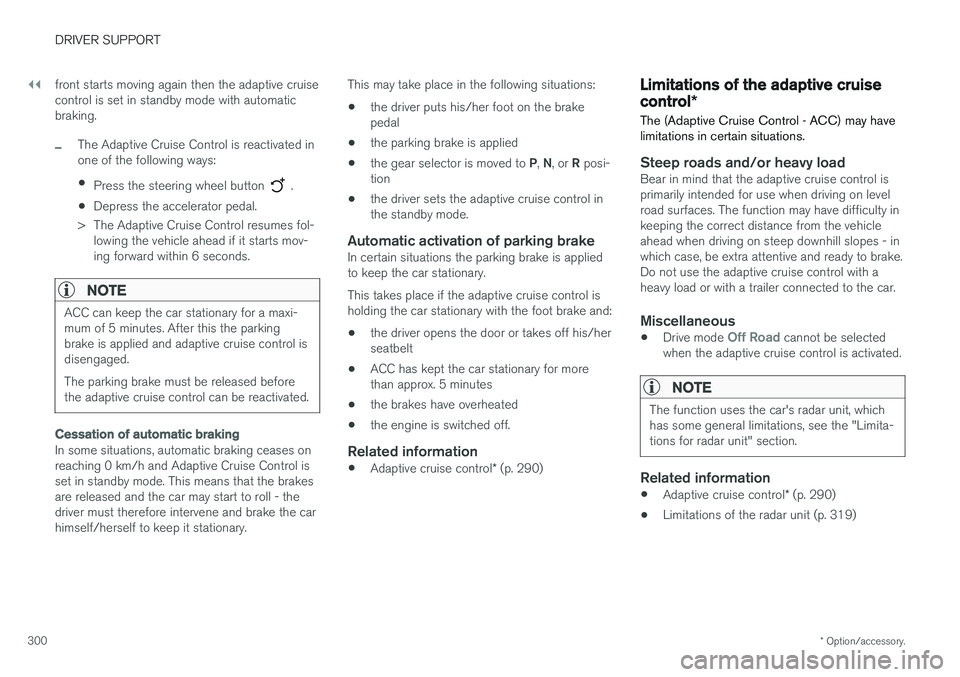
||
DRIVER SUPPORT
* Option/accessory.
300 front starts moving again then the adaptive cruise control is set in standby mode with automaticbraking.
–The Adaptive Cruise Control is reactivated in one of the following ways:
• Press the steering wheel button
.
• Depress the accelerator pedal.
> The Adaptive Cruise Control resumes fol- lowing the vehicle ahead if it starts mov- ing forward within 6 seconds.
NOTE
ACC can keep the car stationary for a maxi- mum of 5 minutes. After this the parkingbrake is applied and adaptive cruise control isdisengaged. The parking brake must be released before the adaptive cruise control can be reactivated.
Cessation of automatic braking
In some situations, automatic braking ceases on reaching 0 km/h and Adaptive Cruise Control isset in standby mode. This means that the brakesare released and the car may start to roll - thedriver must therefore intervene and brake the carhimself/herself to keep it stationary. This may take place in the following situations:
• the driver puts his/her foot on the brakepedal
• the parking brake is applied
• the gear selector is moved to
P, N , or R posi-
tion
• the driver sets the adaptive cruise control inthe standby mode.
Automatic activation of parking brakeIn certain situations the parking brake is appliedto keep the car stationary. This takes place if the adaptive cruise control is holding the car stationary with the foot brake and: •the driver opens the door or takes off his/her seatbelt
• ACC has kept the car stationary for morethan approx. 5 minutes
• the brakes have overheated
• the engine is switched off.
Related information
•
Adaptive cruise control
* (p. 290)
Limitations of the adaptive cruise control *
The (Adaptive Cruise Control - ACC) may have limitations in certain situations.
Steep roads and/or heavy loadBear in mind that the adaptive cruise control is primarily intended for use when driving on levelroad surfaces. The function may have difficulty inkeeping the correct distance from the vehicleahead when driving on steep downhill slopes - inwhich case, be extra attentive and ready to brake.Do not use the adaptive cruise control with aheavy load or with a trailer connected to the car.
Miscellaneous
• Drive mode Off Road cannot be selected
when the adaptive cruise control is activated.
NOTE
The function uses the car's radar unit, which has some general limitations, see the "Limita-tions for radar unit" section.
Related information
• Adaptive cruise control
* (p. 290)
• Limitations of the radar unit (p. 319)
Page 307 of 594
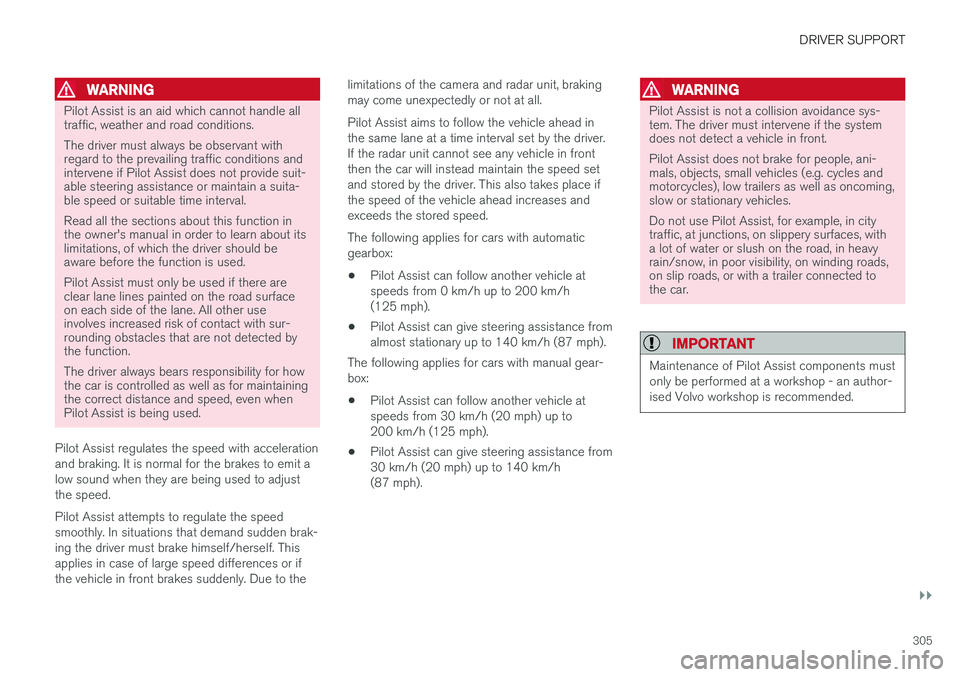
DRIVER SUPPORT
}}
305
WARNING
Pilot Assist is an aid which cannot handle all traffic, weather and road conditions. The driver must always be observant with regard to the prevailing traffic conditions andintervene if Pilot Assist does not provide suit-able steering assistance or maintain a suita-ble speed or suitable time interval. Read all the sections about this function in the owner's manual in order to learn about itslimitations, of which the driver should beaware before the function is used. Pilot Assist must only be used if there are clear lane lines painted on the road surfaceon each side of the lane. All other useinvolves increased risk of contact with sur-rounding obstacles that are not detected bythe function. The driver always bears responsibility for how the car is controlled as well as for maintainingthe correct distance and speed, even whenPilot Assist is being used.
Pilot Assist regulates the speed with acceleration and braking. It is normal for the brakes to emit alow sound when they are being used to adjustthe speed. Pilot Assist attempts to regulate the speed smoothly. In situations that demand sudden brak-ing the driver must brake himself/herself. Thisapplies in case of large speed differences or ifthe vehicle in front brakes suddenly. Due to the limitations of the camera and radar unit, brakingmay come unexpectedly or not at all. Pilot Assist aims to follow the vehicle ahead in the same lane at a time interval set by the driver.If the radar unit cannot see any vehicle in frontthen the car will instead maintain the speed setand stored by the driver. This also takes place ifthe speed of the vehicle ahead increases andexceeds the stored speed. The following applies for cars with automatic gearbox:
• Pilot Assist can follow another vehicle atspeeds from 0 km/h up to 200 km/h(125 mph).
• Pilot Assist can give steering assistance fromalmost stationary up to 140 km/h (87 mph).
The following applies for cars with manual gear-box: • Pilot Assist can follow another vehicle at speeds from 30 km/h (20 mph) up to200 km/h (125 mph).
• Pilot Assist can give steering assistance from30 km/h (20 mph) up to 140 km/h(87 mph).
WARNING
Pilot Assist is not a collision avoidance sys- tem. The driver must intervene if the systemdoes not detect a vehicle in front. Pilot Assist does not brake for people, ani- mals, objects, small vehicles (e.g. cycles andmotorcycles), low trailers as well as oncoming,slow or stationary vehicles. Do not use Pilot Assist, for example, in city traffic, at junctions, on slippery surfaces, witha lot of water or slush on the road, in heavyrain/snow, in poor visibility, on winding roads,on slip roads, or with a trailer connected tothe car.
IMPORTANT
Maintenance of Pilot Assist components must only be performed at a workshop - an author-ised Volvo workshop is recommended.
Page 316 of 594
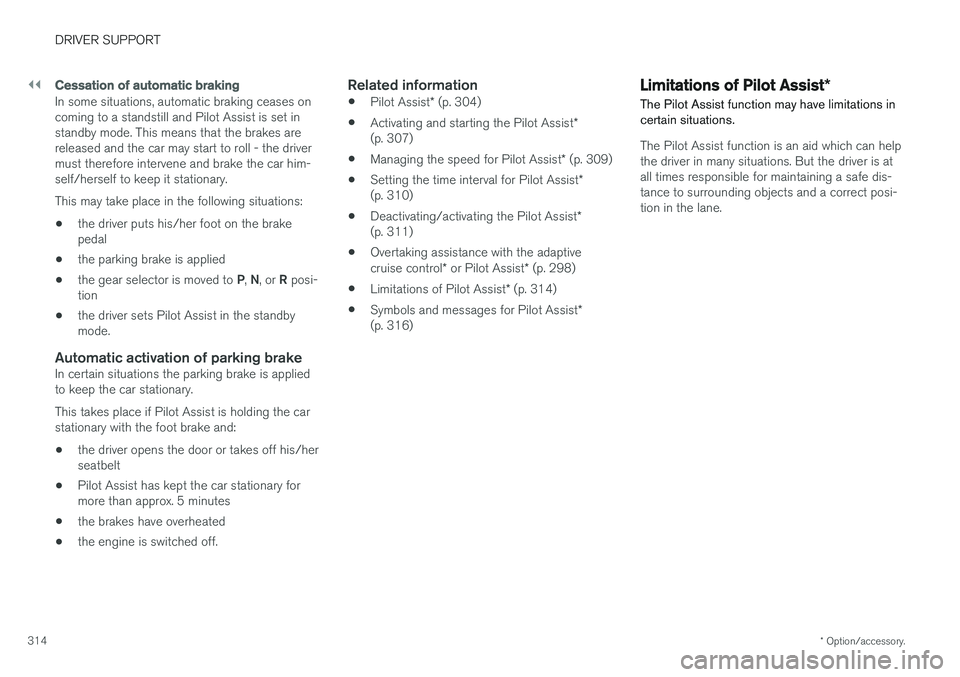
||
DRIVER SUPPORT
* Option/accessory.
314
Cessation of automatic braking
In some situations, automatic braking ceases on coming to a standstill and Pilot Assist is set instandby mode. This means that the brakes arereleased and the car may start to roll - the drivermust therefore intervene and brake the car him-self/herself to keep it stationary. This may take place in the following situations:
• the driver puts his/her foot on the brake pedal
• the parking brake is applied
• the gear selector is moved to
P, N , or R posi-
tion
• the driver sets Pilot Assist in the standbymode.
Automatic activation of parking brakeIn certain situations the parking brake is appliedto keep the car stationary. This takes place if Pilot Assist is holding the car stationary with the foot brake and: •
the driver opens the door or takes off his/her seatbelt
• Pilot Assist has kept the car stationary formore than approx. 5 minutes
• the brakes have overheated
• the engine is switched off.
Related information
•
Pilot Assist
* (p. 304)
• Activating and starting the Pilot Assist
*
(p. 307)
• Managing the speed for Pilot Assist
* (p. 309)
• Setting the time interval for Pilot Assist
*
(p. 310)
• Deactivating/activating the Pilot Assist
*
(p. 311)
• Overtaking assistance with the adaptive cruise control
* or Pilot Assist * (p. 298)
• Limitations of Pilot Assist
* (p. 314)
• Symbols and messages for Pilot Assist
*
(p. 316)
Limitations of Pilot Assist *
The Pilot Assist function may have limitations in certain situations.
The Pilot Assist function is an aid which can help the driver in many situations. But the driver is atall times responsible for maintaining a safe dis-tance to surrounding objects and a correct posi-tion in the lane.
Page 332 of 594
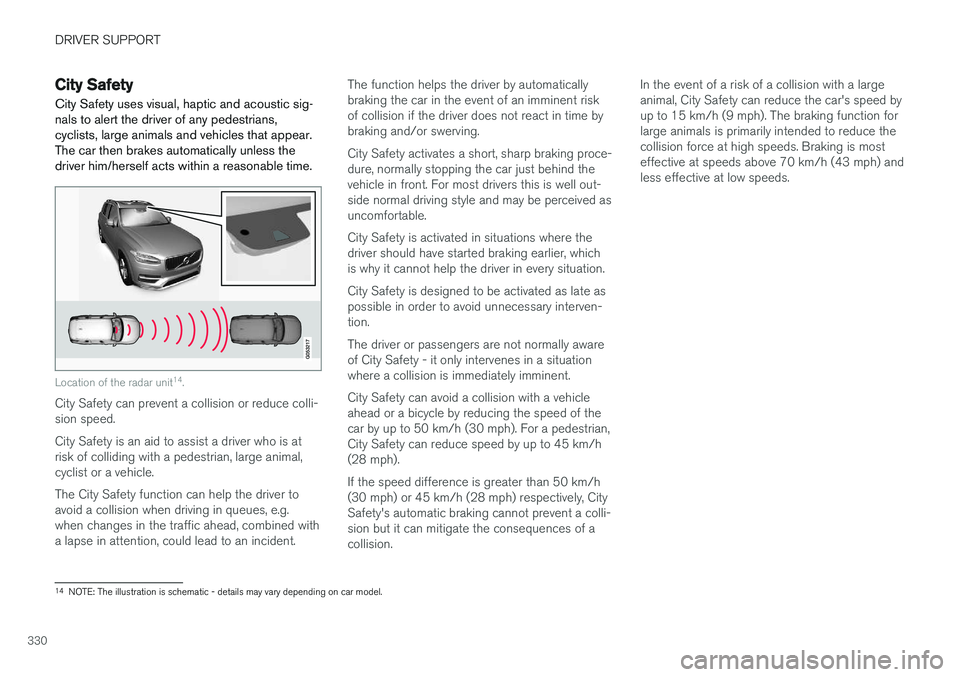
DRIVER SUPPORT
330
City Safety
City Safety uses visual, haptic and acoustic sig- nals to alert the driver of any pedestrians,cyclists, large animals and vehicles that appear.The car then brakes automatically unless thedriver him/herself acts within a reasonable time.
Location of the radar unit 14
.
City Safety can prevent a collision or reduce colli- sion speed. City Safety is an aid to assist a driver who is at risk of colliding with a pedestrian, large animal,cyclist or a vehicle. The City Safety function can help the driver to avoid a collision when driving in queues, e.g.when changes in the traffic ahead, combined witha lapse in attention, could lead to an incident. The function helps the driver by automaticallybraking the car in the event of an imminent riskof collision if the driver does not react in time bybraking and/or swerving. City Safety activates a short, sharp braking proce- dure, normally stopping the car just behind thevehicle in front. For most drivers this is well out-side normal driving style and may be perceived asuncomfortable. City Safety is activated in situations where the driver should have started braking earlier, whichis why it cannot help the driver in every situation. City Safety is designed to be activated as late as possible in order to avoid unnecessary interven-tion. The driver or passengers are not normally aware of City Safety - it only intervenes in a situationwhere a collision is immediately imminent. City Safety can avoid a collision with a vehicle ahead or a bicycle by reducing the speed of thecar by up to 50 km/h (30 mph). For a pedestrian,City Safety can reduce speed by up to 45 km/h(28 mph). If the speed difference is greater than 50 km/h (30 mph) or 45 km/h (28 mph) respectively, CitySafety's automatic braking cannot prevent a colli-sion but it can mitigate the consequences of acollision.In the event of a risk of a collision with a largeanimal, City Safety can reduce the car's speed byup to 15 km/h (9 mph). The braking function forlarge animals is primarily intended to reduce thecollision force at high speeds. Braking is mosteffective at speeds above 70 km/h (43 mph) andless effective at low speeds.
14
NOTE: The illustration is schematic - details may vary depending on car model.
Page 333 of 594
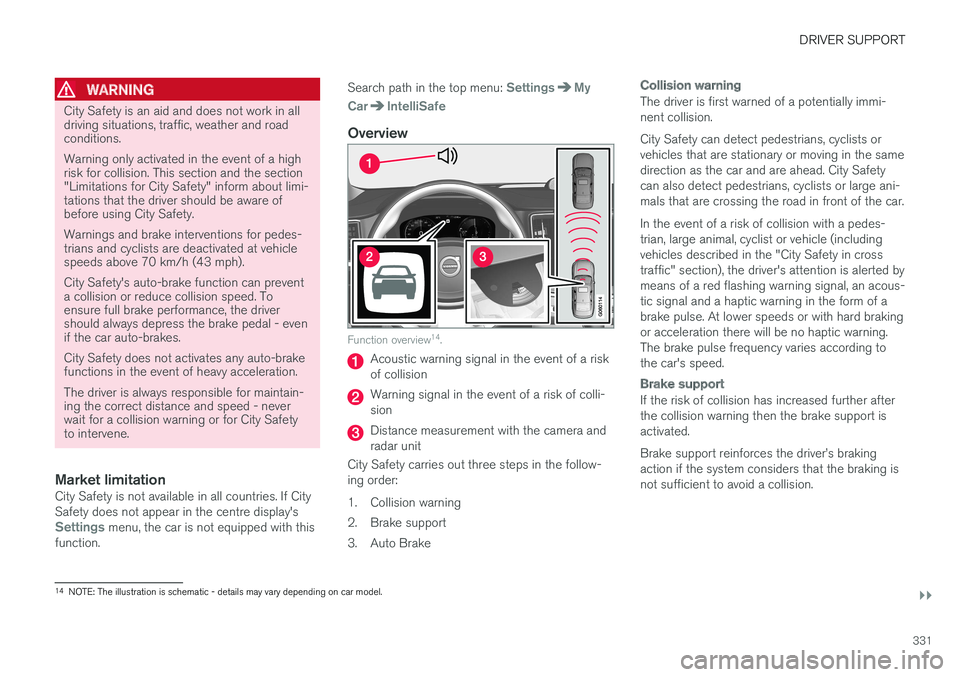
DRIVER SUPPORT
}}
331
WARNING
City Safety is an aid and does not work in all driving situations, traffic, weather and roadconditions. Warning only activated in the event of a high risk for collision. This section and the section"Limitations for City Safety" inform about limi-tations that the driver should be aware ofbefore using City Safety. Warnings and brake interventions for pedes- trians and cyclists are deactivated at vehiclespeeds above 70 km/h (43 mph). City Safety's auto-brake function can prevent a collision or reduce collision speed. Toensure full brake performance, the drivershould always depress the brake pedal - evenif the car auto-brakes. City Safety does not activates any auto-brake functions in the event of heavy acceleration. The driver is always responsible for maintain- ing the correct distance and speed - neverwait for a collision warning or for City Safetyto intervene.
Market limitationCity Safety is not available in all countries. If City Safety does not appear in the centre display's
Settings menu, the car is not equipped with this
function. Search path in the top menu:
SettingsMy
Car
IntelliSafe
Overview
Function overview 14
.
Acoustic warning signal in the event of a risk of collision
Warning signal in the event of a risk of colli- sion
Distance measurement with the camera and radar unit
City Safety carries out three steps in the follow-ing order:
1. Collision warning
2. Brake support
3. Auto Brake
Collision warning
The driver is first warned of a potentially immi- nent collision. City Safety can detect pedestrians, cyclists or vehicles that are stationary or moving in the samedirection as the car and are ahead. City Safetycan also detect pedestrians, cyclists or large ani-mals that are crossing the road in front of the car. In the event of a risk of collision with a pedes- trian, large animal, cyclist or vehicle (includingvehicles described in the "City Safety in crosstraffic" section), the driver's attention is alerted bymeans of a red flashing warning signal, an acous-tic signal and a haptic warning in the form of abrake pulse. At lower speeds or with hard brakingor acceleration there will be no haptic warning.The brake pulse frequency varies according tothe car's speed.
Brake support
If the risk of collision has increased further after the collision warning then the brake support isactivated. Brake support reinforces the driver
Page 334 of 594
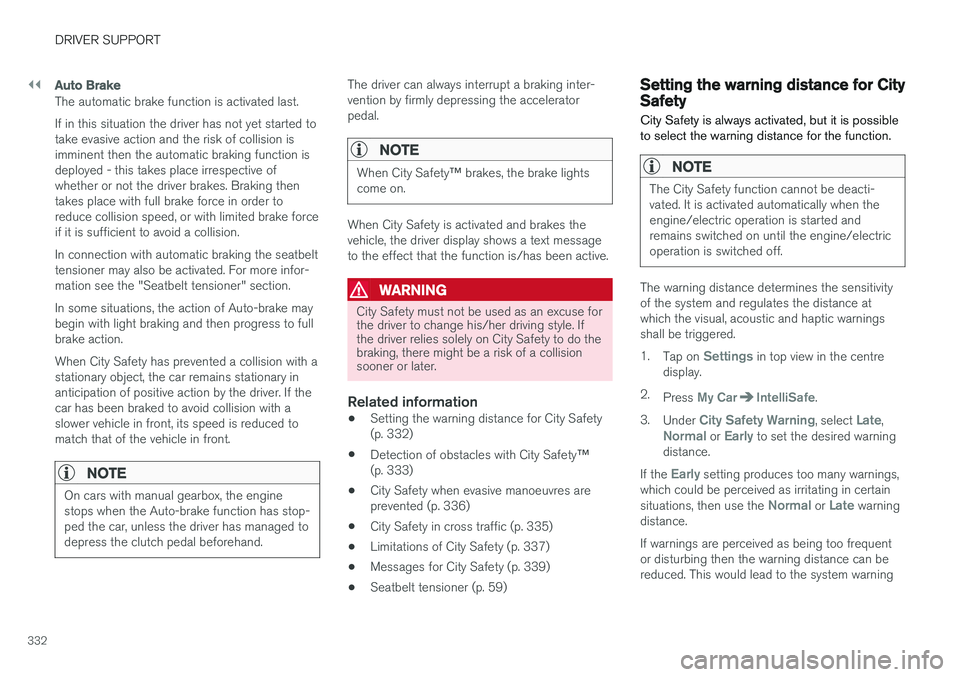
||
DRIVER SUPPORT
332
Auto Brake
The automatic brake function is activated last. If in this situation the driver has not yet started to take evasive action and the risk of collision isimminent then the automatic braking function isdeployed - this takes place irrespective ofwhether or not the driver brakes. Braking thentakes place with full brake force in order toreduce collision speed, or with limited brake forceif it is sufficient to avoid a collision. In connection with automatic braking the seatbelt tensioner may also be activated. For more infor-mation see the "Seatbelt tensioner" section. In some situations, the action of Auto-brake may begin with light braking and then progress to fullbrake action. When City Safety has prevented a collision with a stationary object, the car remains stationary inanticipation of positive action by the driver. If thecar has been braked to avoid collision with aslower vehicle in front, its speed is reduced tomatch that of the vehicle in front.
NOTE
On cars with manual gearbox, the engine stops when the Auto-brake function has stop-ped the car, unless the driver has managed todepress the clutch pedal beforehand.
The driver can always interrupt a braking inter- vention by firmly depressing the acceleratorpedal.
NOTE
When City Safety™ brakes, the brake lights
come on.
When City Safety is activated and brakes the vehicle, the driver display shows a text messageto the effect that the function is/has been active.
WARNING
City Safety must not be used as an excuse for the driver to change his/her driving style. Ifthe driver relies solely on City Safety to do thebraking, there might be a risk of a collisionsooner or later.
Related information
• Setting the warning distance for City Safety (p. 332)
• Detection of obstacles with City Safety
™
(p. 333)
• City Safety when evasive manoeuvres areprevented (p. 336)
• City Safety in cross traffic (p. 335)
• Limitations of City Safety (p. 337)
• Messages for City Safety (p. 339)
• Seatbelt tensioner (p. 59)
Setting the warning distance for City Safety
City Safety is always activated, but it is possible to select the warning distance for the function.
NOTE
The City Safety function cannot be deacti- vated. It is activated automatically when theengine/electric operation is started andremains switched on until the engine/electricoperation is switched off.
The warning distance determines the sensitivity of the system and regulates the distance atwhich the visual, acoustic and haptic warningsshall be triggered. 1. Tap on
Settings in top view in the centre
display.
2. Press
My CarIntelliSafe.
3. Under
City Safety Warning, select Late,Normal or Early to set the desired warning
distance.
If the
Early setting produces too many warnings,
which could be perceived as irritating in certain situations, then use the
Normal or Late warning
distance. If warnings are perceived as being too frequent or disturbing then the warning distance can bereduced. This would lead to the system warning